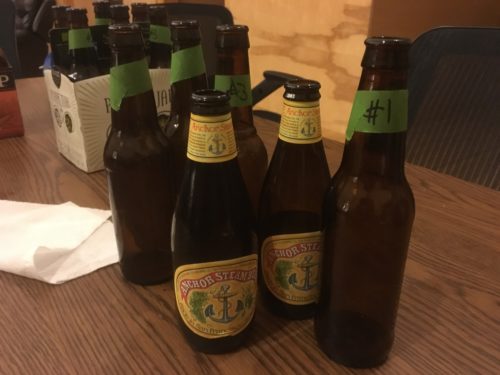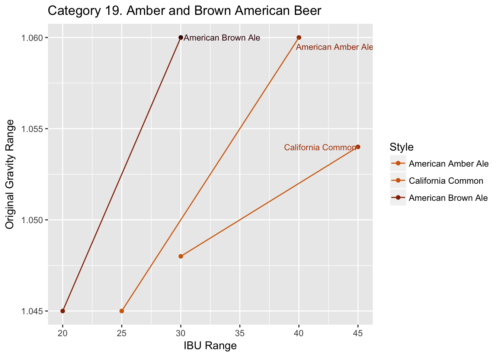BJCP Study Group: Category 19 (and/or Russian Imperial Stouts)
¶ by Rob FrieselFiled under “Best Laid Plans” and/or “Improvising” — our ninth study group session, intended for Category 19 (and coordinated by yours truly) got re-purposed, more or less at the last minute, for a… very special training session:
Judging the 2017 GMM Style Challenge beers: 20C. Imperial Stout
As with the last couple of meetings, there was no guest judge to talk us through philosophy nor style nor technique.
Also, we only sort of tackled the Category 19 beers. Which was slightly to my dismay, as I’d signed up to coordinate this category and thought that I’d done a good job preparing. Oh well! — better to make sacrifice for the greater good when a really interesting training opportunity comes along.
Session Preparation
I was already pretty familiar with the Category 19 beers, especially since they’re among my favorites, and my Honestatis fits roughly into here. That said, I felt like I had learned my lessons since the last time I coordinated, and did my due diligence ahead of time. I had my beers sorted out (19B and 19C right from the “Commercial Examples” section, and 19A being a fresh local example that was solidly to-style) and my palate training exercise ready (a “guess which styles” triangle test).
All that said, it was the day-of prep where I stumbled. I forgot to grab a bottle opener on the way out, and I (again!) forgot the saltines.
Luckily the group was ready to bail me out on both accounts.
Back Story on the Pivot
Two things happened. First, a club meeting was scheduled for the night before the originally scheduled date of this study group session. Given that many of us in the study group couldn’t do two nights in a row, we worked it out such that the study group would get bumped back a week. No harm, no foul.
However, as we worked through the club business during the meeting, the point was raised that the 2017 Style Challenge beers hadn’t yet been scored, nor a winner decided. Seeing an opportunity, Erin did a hand-raise in the meeting to volunteer the study group to take care of the scoring. Awesome! Except for the part where I’d already gotten everything squared away for the Category 19 beers.
That being said, I recognized (as he did) that this would be a good chance for us to do a small-scale judging experience — complete with flights and a Best of Show round. How could we not, as a group of aspiring judges, take this opportunity?
I agreed with the proposal.
Honestly, it was a small sacrifice to make since now I got to keep the Category 19 beers that I’d purchased for the group.
Category 19: Amber and Brown American Beer
Category 19 is one which really does seem to be descriptively named. Each of the three styles seems distinctly American in its profile (i.e., tending to favor a more hop-forward and bitter balance), and/but is otherwise defined by color (i.e., 10 SRM at the lightest, and 17 at the darkest, unless we’re talking browns which can get up to 35). They’re all moderate in strength and bitterness, and though (as mentioned) they tend to lean toward the bitter in their balance, all three should have a distinct malt character. Citrusy hops seem to be typical — except for the steam beers, which need a more rustic touch. In each case, if the hop profile becomes too pronounced, they move into 21B. Specialty IPA territory (i.e., “Red IPA” and “Brown IPA”).
| 19A. American Amber Ale | 19B. California Common | 19C. American Brown Ale |
|---|---|---|
| 25 – 40 IBU | 30 – 45 IBU | 20 – 30 IBU |
| 1.045 – 1.060 O.G. | 1.048 – 1.054 O.G. | 1.045 – 1.060 O.G. |
| 1.010 – 1.015 F.G. | 1.011 – 1.014 F.G. | 1.010 – 1.016 F.G. |
| 4.5 – 6.2% ABV | 4.5 – 5.5% ABV | 4.3 – 6.2% ABV |
And as for the night of the study group… while the evening would be dominated by the Imperial Stout scoring, we did “calibrate” and/or “re-engage” with the judging mindset by tackling one of the in-category beers.
- 19B. California Common. Anchor Steam. Everyone seemed to get right back into the swing of structured evaluations and judging. The spread of scores went from 34 to 46, but were mostly in the high-30s. Even among those that scored it well, most agreed that these specimens seemed too malty given the style guidelines. We wondered if it had oxidized (possible, but unlikely given their reasonable freshness) or if it was simply a bad batch (also seemed unlikely given that… well, it’s a Big Name commercial brand which practically served as the origin of this style).
- Setting up the flights. We had 8 present for the study group, and 6 distinct beers that had been entered into the club style challenge. We broke up the entries into flights of two, and then split ourselves into two groups of three and one group of two. My group got entries #5 and #6. As a group, we briefly took a moment to walk through the 20C. Imperial Stout guidelines which… well, there’s lots of room for brewer interpretation.
- Judging. I tried to apply what I’d learned at the Fair. We kept a strict 15 minute time limit to the structured tasting. We left the discussion section unbounded, but I’d estimate that we never spent more than about five or six minutes talking through the scores. For my group, the scores for the first beer were tightly clustered (all within 3 points of each other) and favorable (aggregate average 39.3); meanwhile the second beer was much more contention, with an eight point spread between us that we eventually got down to five (aggregate average 34).
- Best of Show. The B.O.S. round was all eight of us having a spirited debate about the relative merits of three seemingly very different interpretations of the 20C style. There was a lot of discussion. There was a lot of disagreement. There was a lot of nit-picking and hair-splitting and heel-digging. We were split right down the middle for two of the entries. Ultimately it came down to instant-runoff voting. Ultimately the #1 tagged entry won.
P.S. 19C. American Brown Ale. Smuttynose Old Brown Dog. After I got home, I popped the cap on one and did a structured evaluation on it. (It fared OK though I don’t know that I would put this in my regular rotation.)
Takeaways
Themes and broad observations from the night:
- Be flexible. If you’re coordinating and a really good opportunity comes up for the group to do something cool: don’t balk — just run with it. It’ll be worth it.
- If you’re coordinating: PREPARE. Forgot a bottle opener. Forgot saltines. Spared by my peers on both counts, but so embarrassed.
- Palate fatigue! I’ve talked about this before but it’s worth mentioning again. This hit home during the Fair because of the hoppy beers in our flight but… I’ve now also developed an appreciation for what a big, malty, boozy stout can wreck as well.
- Some styles are very subjective. One of the most interesting things about judging a flight of 20C beers was just how much room for interpretation there is. I feel like we encountered this before with Category 11, Category 18, and Category 2 — but this was a place where it really hit home. Two things that I picked up on: two judges could have pretty different interpretations of a broad style and then dig in their heels over specific details — e.g., they might agree that a beer wasn’t bitter enough, but one might forgive that if the malt complexity is there while another may not. Another thing I noticed was that when you have a style where almost anything is negotiable, that it becomes easy to generalize that to all aspects of the style, even those which are not — e.g., 20C. Imperial Stout permits a broad range of malt flavors and intensities, hop flavors and intensities, esters… but they should be decidedly opaque.
- And the B.O.S. round is even more subjective. Let’s say it again: everyone’s palate is different, so everyone is going to pick up different things, and there’s only so much convincing you can do in this area. At certain points of the debate, I found myself thinking Who are you people that you think [fill in the blank aspect about some given beer]? Nevertheless, we managed to converge on a winner (however clumsily).
About Rob Friesel
Software engineer by day. Science fiction writer by night. Weekend homebrewer, beer educator at Black Flannel, and Certified Cicerone. Author of The PhantomJS Cookbook and a short story in Please Do Not Remove. View all posts by Rob Friesel →4 Responses to BJCP Study Group: Category 19 (and/or Russian Imperial Stouts)
Pingback: BJCP Exam (“It’s done.”) | found drama


Leave a Reply